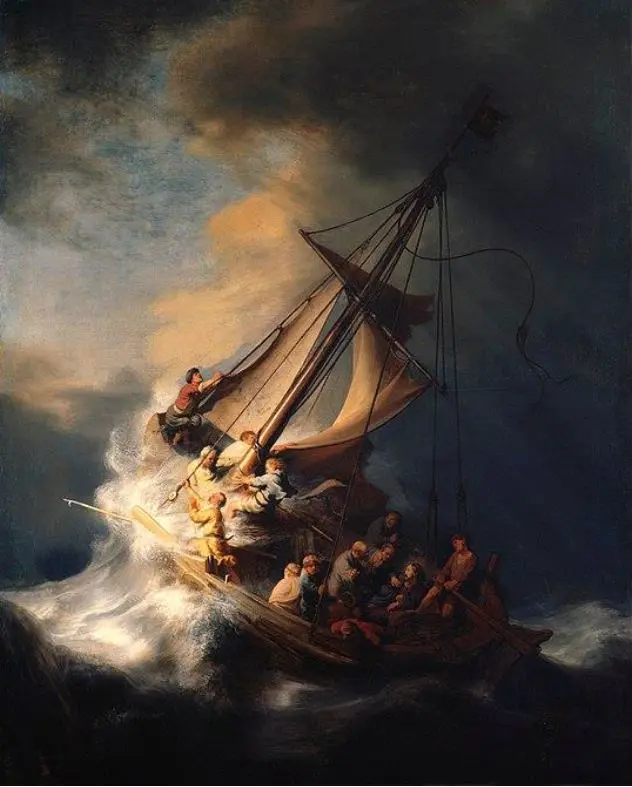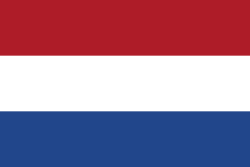Guestblog by Isabella Duval
The Netherlands, a country long celebrated for its pioneering water management and adaptative ingenuity, now finds itself threatened by the very force it once claimed to control. With 26% of its land lying below sea level and projections indicating a rise in the North Sea by 1.6 meters by 2100, this low-lying densely populated delta stands on precarious grounds. Over half of the Dutch population lives in areas at risk, as climate change brings not only rising seas but heavier rainfall and unstable weather patterns[1]. Even the most sophisticated systems of dikes and water engineering systems may not hold back what is coming. But how do we truly comprehend a catastrophe that unfolds so slowly, yet so relentlessly? Maybe art can help us grasp what data and policy briefs often cannot.
In my perception, two artworks, separated by centuries but joined by water, can provide a lens through which to view our collective predicament: Rembrandt’s Jesus in a Storm on the Sea of Galilee (1633) and Bas Jan Ader’s project In Search of the Miraculous (1975). Each work portrays a vessel at sea: Rembrandt’s painting depicts the biblical story of Jesus calming the storm, while Ader’s work has no explicit connection to religious faith[2]. Nevertheless, both works can be understood as exploring different trajectories through themes of uncertainty and the human struggle to navigate forces beyond our control. In doing so, they each touch on a broader concept of faith, as defined by theologian James Fowler. Fowler suggests that faith is not about belief or religious affiliation, but about a fundamental human orientation toward meaning and transcendence[3]. Faith, in this sense, is a universal aspect of human life that transcends cultural and religious boundaries. It is a dynamic, evolving process through which individuals shape, maintain, and transform meaning, gradually moving from external authority to internal, personal conviction.
In what follows, I will show how, when put in a dialogue with each other, the works of Rembrandt and Ader can articulate a tension that powerfully reflects the Dutch relationship with water - which has been historically shaped by the country’s simultaneous reliance on and vulnerability to the sea- and how this relationship is now being challenged by climate change.

(source: public domain)
© The Estate of Bas Jan Ader
Rembrandt’s painting, his only known seascape, captures a moment of violent upheaval. It tells the biblical story of Jesus Calming the Storm. Because he needed respite, Jesus decided to sail with his disciples to the opposite shore of the Sea of Galilee. Not long after the boat sailed off, he fell
asleep. Shortly after, a storm arose, but the heavy sea and the violent winds did not wake him up: “the waves were breaking into the boat, so that the boat was already filling”[4]. Jesus and his disciples are caught in a raging storm on the Sea of Galilee, their boat is nearly capsizing, their faces are twisted in terror and faith. It is a scene of chaos and existential vulnerability, where survival hinges not merely on human action and mastery but also on spiritual surrender. The composition invites us to confront not only our helplessness before the overwhelming forces of nature, but also the transformative power of faith amidst fear and uncertainty. Within the Dutch climate context, Rembrandt’s tempestuous canvas may appear uncannily prophetic, offering at first glance a striking visual metaphor for rising seas and collective denial, a nation suspended in the midst of a storm, yet still clinging to the illusion of impending calm.
Rembrandt’s painting offers a striking contrast with Ader’s minimalist photograph, which documents the beginning of his solo journey across the ocean - the central performance of his project In Search of the Miraculous: a small sailboat gliding into the horizon beneath a vast and tranquil sky. This solo voyage was Ader’s final, fatal performance. Just three weeks after his departure, all radio contact ceased. By April 1976, his boat was found off the coast of Ireland, empty: his body was never recovered. This image of him aboard his small vessel setting sail from Cape Code suggests quiet determination, but also the illusion of control. Unlike Rembrandt’s disciples, Ader goes alone, in search of something miraculous, something beyond reason. His journey blurs the line between courage, recklessness and surrender, intentionality and fate.
These two seascapes - Rembrandt’s tempest and Ader’s stillness - capture the paradox at the heart of the Dutch climate situation in the face of the unpredictability of nature. The first stands for chaos if we wait too long; the second suggests the danger of drifting too far into inaction, mistaking stillness for safety and placing too much confidence in our own power. In this sense, both works speak to the deep cultural entanglement of the Netherlands with water. As investigated by cultural theorist Lotte Jensen in Wij en het water – een Nederlandse geschiedenis (2022), Dutch identity has been deeply shaped by the struggle against the sea [5]. The Delta Works, dikes and canals are not just mere infrastructure, she writes, they are national monuments and integral to Dutch identity. Yet this legacy, long a source of national pride, risks becoming a trap as it has gradually fostered overconfidence in technological solutions for water management, and thereby created a sense of control that may obscure the country’s increasing vulnerability to climate change. In this context, Ader’s sailboat, adrift on calm waters beneath tranquil skies becomes a poignant metaphor for a nation lulled by its own past successes, quietly drifting toward an upcoming storm it refuses to fully acknowledge. In this light, the climate crisis is not only an ecological but also a spiritual challenge. How do we live in the face of ecological unstability? How do we act when the future is uncertain, and the present still seems deceptively stable?
In De God van Rembrandt, theologian Gerda Hoekveld-Meijer notes that, of the fifteen men aboard the vessel in Rembrandt’s painting, five are actively struggling to save the ship and its crew; these figures are notably illuminated as they act [6]. According to Hoekveld-Meijer, Rembrandt uses his masterful chiaroscuro not only for dramatic effect but to make a theological statement: he casts into darkness those who cry out for divine intervention, while bringing into the the light those who translate their faith into action in order to preserve themselves and others. In this sense, the central theme of Rembrandt’s work is not the miraculous calming of the storm itself, but rather the transformative power of faith expressed through love, solidarity and action. Ader, by contrast, sails in silence, placing his trust in the journey itself. Ergo, faith, whether religious, artistic, or civic, emerges not only as a central theme to both Rembrandt’s and Ader’s artworks, but also underpins the broader narrative of climate transition. Between them, a profound tension unfolds, a tension that deeply resonates with the current Dutch dilemma: do we place our hope in being saved, or do we assume responsibility and become the agents of our own salvation?
Art does not provide solutions, but it can offer valuable insights. These two vessels, adrift in their own eras, hold a mirror to our time. They remind us that climate change is not only a technical challenge but a profound human story of fear and faith, action and surrender, survival and acceptation. In the end, perhaps we are all like Bas Jan Ader in search of the miraculous: a moment of clarity, a turning of the tide. Nevertheless, one thing is certain: this search must begin with a genuine recognition of our vulnerability to the unpredictable power of the elements, coupled with the faith that we can take meaningful action to ensure a sustainable and liveable future for human and nonhumans inhabiting our shared home. Before the next storm arises, we face a crucial choice: whether to be like Rembrandt’s panicked passengers, overwhelmed and even despairing, or to embody Ader’s silent sailor, calm and deliberate in the face of uncertainty, yet mindful not to slip into any overconfidence. We must decide whether we will meet the approaching horizon with purpose, clarity and resolve, or be swept away by nature’s unpredictability and power. Ultimately, as Rutger Bregman emphasizes in his essay, Het Water Komt – Een Brief Aan Alle Nederlanders (2020) “One thing is certain: if we want to preserve our country, we must fight. Fight against the water, and fight against ourselves”[7]. This call to action underscores the urgent need to confront not only external threats such as rising waters, but also to overcome internal obstacles, like division, inertia and complacency, in order to safeguard our collective future.
As Delta commissioner Peter Glas puts it: “In the long term, the Netherlands will become amphibious. We must move with where the water takes us” (quoted in Jensen, p. 165) [8]. This entails the imperative of a cultural shift - from viewing water as just a hostile force to envisioning a relationship with water built on respect, coexistence and collaboration. Alongside a sense of humility and an aknowledgment of our vulnerability, faith, whether expressed through religion, art, or civic commitment, continues to play an essential role in this endeavor. Indeed, as seen in the works of Rembrandt and Ader, faith provides the foundation for hope and serves as a catalyst for action, empowering us to confront uncertainty with both courage and compassion. It is through this shared belief in the possibility of change and the power of collective effort that we can navigate the storms ahead and strive toward a sustainable and equitable future for all inhabitants of our planet, humans and nonhumans alike.
Isabelle Duval
References:
1 Utrecht University. https://www.uu.nl/en/news/new-high-end-estimate-of-sea-level-rise-projections-for-2100-and-2300
2 Mark 4: 35-41, Jesus Calms the Storm; Matthew 8: 23-27, Only Christ Remains Calm; Luke 8: 22-24, Jesus Calms the Storm.
3 Fowler, J. (1986). “Faith and the Structuring of Meaning” in Faith Development and Fowler, ed. by Craig Dykstra & Sharon Parks, Birmingham: Religious Education Press, pp.15-42.
4 Mark 4: 35-41, Jesus Calms the Storm; Matthew 8: 23-27, Only Christ Remains Calm; Luke 8: 22-24, Jesus Calms the Storm.
5 Jensen, L. (2022). Wij en het water – een Nederlandse geschiedenis. Amsterdam: De Bezige Bij.
6 Hoekveld-Meijer, G. (2005). De God van Rembrandt. Zoetermeer: Uitgeverij Meineman.
7 “Eén ding is zeker: willen we ons land behouden, dan moeten we strijd leveren. Strijd tegen het water, en strijd tegen onszelf.” Bregman, R. (2020). Het water komt. p. 14.
8 “Op lange termijn wordt Nederland amfibisch. Wij moeten meebewegen met waar het water ons brengt”, quoted by Jensen, Ibid. p. 165. (translation by Duval)


The Dutch Calm before the Storm: Art, Faith and Climate change